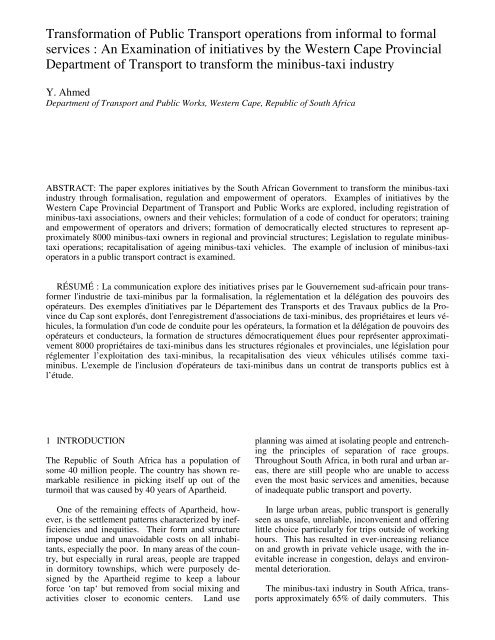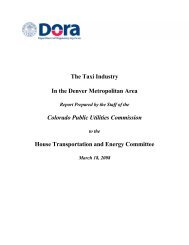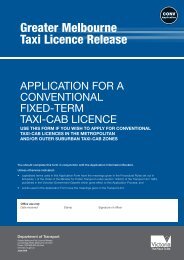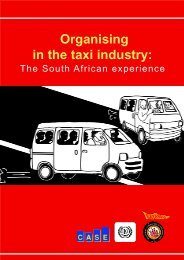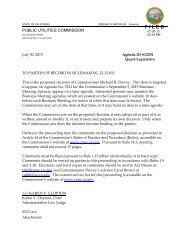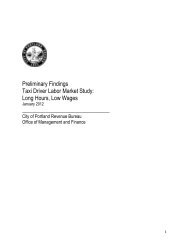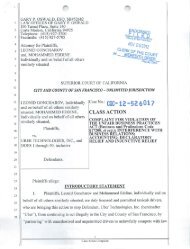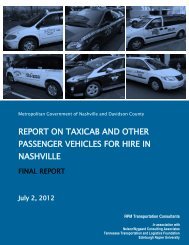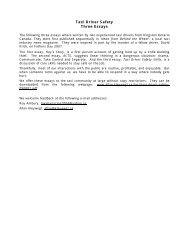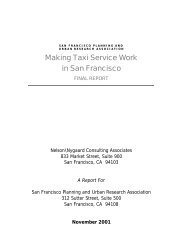Transformation of Public Transport operations from ... - Taxi Library
Transformation of Public Transport operations from ... - Taxi Library
Transformation of Public Transport operations from ... - Taxi Library
You also want an ePaper? Increase the reach of your titles
YUMPU automatically turns print PDFs into web optimized ePapers that Google loves.
<strong>Transformation</strong> <strong>of</strong> <strong>Public</strong> <strong>Transport</strong> <strong>operations</strong> <strong>from</strong> informal to formal<br />
services : An Examination <strong>of</strong> initiatives by the Western Cape Provincial<br />
Department <strong>of</strong> <strong>Transport</strong> to transform the minibus-taxi industry<br />
Y. Ahmed<br />
Department <strong>of</strong> <strong>Transport</strong> and <strong>Public</strong> Works, Western Cape, Republic <strong>of</strong> South Africa<br />
ABSTRACT: The paper explores initiatives by the South African Government to transform the minibus-taxi<br />
industry through formalisation, regulation and empowerment <strong>of</strong> operators. Examples <strong>of</strong> initiatives by the<br />
Western Cape Provincial Department <strong>of</strong> <strong>Transport</strong> and <strong>Public</strong> Works are explored, including registration <strong>of</strong><br />
minibus-taxi associations, owners and their vehicles; formulation <strong>of</strong> a code <strong>of</strong> conduct for operators; training<br />
and empowerment <strong>of</strong> operators and drivers; formation <strong>of</strong> democratically elected structures to represent approximately<br />
8000 minibus-taxi owners in regional and provincial structures; Legislation to regulate minibustaxi<br />
<strong>operations</strong>; recapitalisation <strong>of</strong> ageing minibus-taxi vehicles. The example <strong>of</strong> inclusion <strong>of</strong> minibus-taxi<br />
operators in a public transport contract is examined.<br />
RÉSUMÉ : La communication explore des initiatives prises par le Gouvernement sud-africain pour transformer<br />
l'industrie de taxi-minibus par la formalisation, la réglementation et la délégation des pouvoirs des<br />
opérateurs. Des exemples d'initiatives par le Département des <strong>Transport</strong>s et des Travaux publics de la Province<br />
du Cap sont explorés, dont l'enregistrement d'associations de taxi-minibus, des propriétaires et leurs véhicules,<br />
la formulation d'un code de conduite pour les opérateurs, la formation et la délégation de pouvoirs des<br />
opérateurs et conducteurs, la formation de structures démocratiquement élues pour représenter approximativement<br />
8000 propriétaires de taxi-minibus dans les structures régionales et provinciales, une législation pour<br />
réglementer l’exploitation des taxi-minibus, la recapitalisation des vieux véhicules utilisés comme taximinibus.<br />
L'exemple de l'inclusion d'opérateurs de taxi-minibus dans un contrat de transports publics est à<br />
l’étude.<br />
1 INTRODUCTION<br />
The Republic <strong>of</strong> South Africa has a population <strong>of</strong><br />
some 40 million people. The country has shown remarkable<br />
resilience in picking itself up out <strong>of</strong> the<br />
turmoil that was caused by 40 years <strong>of</strong> Apartheid.<br />
One <strong>of</strong> the remaining effects <strong>of</strong> Apartheid, however,<br />
is the settlement patterns characterized by inefficiencies<br />
and inequities. Their form and structure<br />
impose undue and unavoidable costs on all inhabitants,<br />
especially the poor. In many areas <strong>of</strong> the country,<br />
but especially in rural areas, people are trapped<br />
in dormitory townships, which were purposely designed<br />
by the Apartheid regime to keep a labour<br />
force ‘on tap‘ but removed <strong>from</strong> social mixing and<br />
activities closer to economic centers. Land use<br />
planning was aimed at isolating people and entrenching<br />
the principles <strong>of</strong> separation <strong>of</strong> race groups.<br />
Throughout South Africa, in both rural and urban areas,<br />
there are still people who are unable to access<br />
even the most basic services and amenities, because<br />
<strong>of</strong> inadequate public transport and poverty.<br />
In large urban areas, public transport is generally<br />
seen as unsafe, unreliable, inconvenient and <strong>of</strong>fering<br />
little choice particularly for trips outside <strong>of</strong> working<br />
hours. This has resulted in ever-increasing reliance<br />
on and growth in private vehicle usage, with the inevitable<br />
increase in congestion, delays and environmental<br />
deterioration.<br />
The minibus-taxi industry in South Africa, transports<br />
approximately 65% <strong>of</strong> daily commuters. This
market share has steadily increased over the last<br />
twenty years, as rail and bus services have deteriorated,<br />
despite large government subsidies. The unsubsidized<br />
minibus-taxi industry at first filled the<br />
gaps in mobility needs <strong>of</strong> people and became attractive<br />
to township dwellers in that it <strong>of</strong>fered almost a<br />
door to door service to commuters. The minibustaxi<br />
industry also represented a community-based<br />
industry that provided a service in defiance <strong>of</strong> the<br />
apartheid government. Thus, during the boycott <strong>of</strong><br />
bus services during the 1980’s, the minibus-industry<br />
grew at a remarkable pace. This growth in the number<br />
<strong>of</strong> minibus-taxis was further fuelled by an inadequate<br />
regulatory system, which to some extent was<br />
ignored by operators as a further statement <strong>of</strong> defiance<br />
against the government <strong>of</strong> the time.<br />
With the coming <strong>of</strong> democracy to South Africa in<br />
1994, the new government placed a high priority on<br />
improving the mobility and access to opportunities<br />
<strong>of</strong> all communities. The vital role that the minibustaxi<br />
industry plays in the transport arena could not be<br />
ignored, but neither could the inadequacies and inefficiencies<br />
<strong>of</strong> minibus-taxi services and <strong>operations</strong>.<br />
This paper describes how the post-apartheid government<br />
has approached the transformation and formalisation<br />
<strong>of</strong> the minibus-taxi industry. Initiatives<br />
by the Western Cape provincial government to incorporate<br />
the minibus-taxi industry into formalized,<br />
contracted public transport <strong>operations</strong> are explored<br />
in more detail.<br />
2 BACKGROUND<br />
2.1 The Western Cape Province<br />
The Western Cape province is home to some 4.5<br />
million people, with 70% living and working in and<br />
around the City <strong>of</strong> Cape Town. A Provincial Parliament,<br />
governs the province with an Executive or<br />
Cabinet <strong>of</strong> 11 members, led by a Premier.<br />
The province has an urbanization level <strong>of</strong> around<br />
59%, and covers an area <strong>of</strong> approximately 120<br />
000km 2 ,which represents 10% <strong>of</strong> the area <strong>of</strong> the Republic<br />
<strong>of</strong> South Africa. The province’s share to the<br />
South African Gross Domestic Product is approximately<br />
15%.<br />
The province has a robust economy, with diverse<br />
and balanced primary activities – agriculture, fishing<br />
and forestry – plus an equally diverse range <strong>of</strong> manufacturing<br />
sub-sectors, a vibrant and rapidly growing<br />
tourism sector and an increasing array <strong>of</strong> futureoriented<br />
service industries.<br />
With the completion <strong>of</strong> the Cape Town International<br />
Convention Centre, Cape Town is set to become<br />
even more popular as a venue for international<br />
conferences and meetings <strong>of</strong> leaders. Cape Town is<br />
also the seat <strong>of</strong> South Africa’s parliament and with<br />
its cultural diversity and colorful history is the favored<br />
domestic tourist destination.<br />
The Western Cape’s rural areas include South Africa’s<br />
famous ‘Garden Route’ with its administrative<br />
center in George. Popular tourist attractions are <strong>of</strong>fered<br />
in rural towns along the East coast such as<br />
Oudtshoorn (the Cango Caves), Knysna and Plettenberg<br />
Bay. Along the West Coast, the area between<br />
Saldanha to Vredenburg has become a new industrial<br />
hub, with the development <strong>of</strong> the vast Saldanha Steel<br />
Complex. Clanwilliam and Lamberts Bay, also<br />
along the West Coast, are agricultural and fishing<br />
centers. Closer to the City <strong>of</strong> Cape Town, idyllic<br />
‘Boland’ towns are mostly shaped by wine and fruit<br />
farming and are also very popular tourist destinations.<br />
2.2 <strong>Public</strong> <strong>Transport</strong> in the Western Cape<br />
The Western Cape is generally well endowed with<br />
movement resources. There is an extensive main<br />
road network joining all the major centers and a relatively<br />
dense network <strong>of</strong> graveled roads joining rural<br />
settlements and farms. In the City <strong>of</strong> Cape Town,<br />
there is a well developed arterial road system and an<br />
established rail network. Road based public transport<br />
services are provided by a large fleet <strong>of</strong> buses<br />
and minibuses.<br />
Although the infrastructure for public transport in<br />
the Western Cape is well established, public transport<br />
<strong>operations</strong> are characterized by inefficiencies<br />
and ineffectiveness. In the case <strong>of</strong> rail, the inefficient<br />
operation <strong>of</strong> services and deteriorating safety<br />
and security at stations and on carriages, have resulted<br />
in a steadily declining ridership. In preparing<br />
Current <strong>Public</strong> <strong>Transport</strong> Records for the City <strong>of</strong><br />
Cape Town, morning peak boardings towards and<br />
<strong>from</strong> the Cape Town city center were surveyed in<br />
1998, 2000 and 2002. The results confirmed this<br />
negative trend and are shown in Figure 1.<br />
Boardings<br />
300000<br />
250000<br />
200000<br />
150000<br />
100000<br />
50000<br />
0<br />
To CT From CT Total<br />
Figure 1. Cape Town Rail Boardings - Morning Peak<br />
1998<br />
2000<br />
2002
In comparison to the declining rail commuter<br />
numbers, the ridership on minibus-taxis has been<br />
steadily increasing. Table 1, below, which is<br />
sourced <strong>from</strong> Part 2 <strong>of</strong> the Cape Metropolitan <strong>Transport</strong><br />
Plan, shows the shift in modal share between<br />
rail, bus and minibus between 1987 and 1998. This<br />
trend has continued and has been confirmed in surveys<br />
towards the 2002 current public transport record.<br />
Table 1. Modal share in the City <strong>of</strong> Cape Town<br />
1987 1998 2000<br />
Rail 65% 62% 62%<br />
Bus 24% 18% 14%<br />
Minibus 11% 20% 24%<br />
In its White Paper on Western Cape Provincial<br />
<strong>Transport</strong> Policy (1997) the Western Cape Department<br />
<strong>of</strong> <strong>Transport</strong> and <strong>Public</strong> Works identifies inadequate<br />
and poor performance across a range <strong>of</strong> activities<br />
related to public transport, including<br />
operational and strategic planning, accident prevention,<br />
public transport planning and <strong>operations</strong>, policy<br />
coordination, law enforcement, funding and subsidization.<br />
In 2001 the Western Cape Department <strong>of</strong> <strong>Transport</strong><br />
and <strong>Public</strong> Works was restructured and a <strong>Public</strong><br />
<strong>Transport</strong> Branch was formed. Under new political<br />
leadership, the Branch developed a Provincial Vision<br />
for <strong>Public</strong> <strong>Transport</strong> and Five Year Strategic Delivery<br />
Programme, which was made public in April<br />
2003. A large focus <strong>of</strong> this strategic plan is on the<br />
transformation <strong>of</strong> scheduled and unscheduled services<br />
and the inclusion <strong>of</strong> the minibus-taxi industry<br />
in planned contracts. In order to get to the point<br />
where a very fragmented and volatile minibus-taxi<br />
industry can meaningfully participate in formal contracts,<br />
the province has focused on the empowerment<br />
and formalisation <strong>of</strong> the minibus-taxi industry. The<br />
next chapter introduces national and provincial initiatives<br />
towards this goal <strong>of</strong> transforming, formalizing<br />
and empowering the minibus-taxi industry.<br />
3 TRANSFORMATION OF THE MINIBUS-TAXI<br />
INDUSTRY<br />
3.1 The National <strong>Taxi</strong> Task Team<br />
After South Africa’s first democratic elections in<br />
1994, the new government set out to address many<br />
<strong>of</strong> the past injustices and imbalances created through<br />
apartheid. In the case <strong>of</strong> access to mobility, the<br />
newly appointed Minister <strong>of</strong> <strong>Transport</strong> at the time,<br />
Mac Maharaj, realized that any solution to the problems<br />
facing public transport could not ignore the<br />
minibus-taxi industry, nor could it ignore the problems<br />
that existed in this volatile industry.<br />
By 1995, violence between rival taxi groups over<br />
control <strong>of</strong> lucrative routes and areas, had spiraled out<br />
<strong>of</strong> control. Solutions had to be found, but those solutions<br />
had to be developed in close consultation with<br />
the minibus-taxi industry. The national Department<br />
<strong>of</strong> <strong>Transport</strong> established the National <strong>Taxi</strong> Task<br />
Team, (NTTT) consisting <strong>of</strong> 9 taxi industry representatives<br />
(1 <strong>from</strong> each province), 9 Government<br />
representatives (representing all three tiers <strong>of</strong> Government)<br />
and 9 specialist advisors. The mandate <strong>of</strong><br />
the NTTT was to investigate the issues affecting the<br />
taxi industry and formulate recommendations to the<br />
Minister <strong>of</strong> <strong>Transport</strong> to address them.<br />
The NTTT focused on three key areas in the<br />
process <strong>of</strong> transforming the taxi industry, namely<br />
Regulation and control; Formalisation and Training<br />
and Economic assistance. After a long process <strong>of</strong><br />
consultation with stakeholders across the spectrum,<br />
the NTTT published its final recommendations on 6<br />
August 1996.<br />
These recommendations were presented to Parliament<br />
and were adopted by the national Cabinet as<br />
Government’s plan <strong>of</strong> action for transforming the<br />
minibus-industry. All provinces, in consultation<br />
with the provincial taxi industries and communities<br />
set about implementing these recommendations. In<br />
the Western Cape, a Provincial <strong>Taxi</strong> Working Group<br />
was established by the provincial Department <strong>of</strong><br />
<strong>Transport</strong> and <strong>Public</strong> Works to manage the implementation<br />
<strong>of</strong> the NTTT recommendations.<br />
The following paragraphs provide details on key<br />
areas <strong>of</strong> implementation and the lessons learnt<br />
through the processes that were followed.<br />
3.2 Registration <strong>of</strong> minibus-taxi operators<br />
With the history <strong>of</strong> apartheid, it is understandable<br />
that there remains a high level <strong>of</strong> suspicion <strong>of</strong> Government<br />
by previously disenfranchised communities.<br />
In the case <strong>of</strong> the minibus-taxi industry, there was<br />
trust in the political <strong>of</strong>fice bearers who had made<br />
their mark in the struggle for liberation. There was,<br />
however, still a high level <strong>of</strong> mistrust <strong>of</strong> Government<br />
<strong>of</strong>ficials and Departments, despite changes at the<br />
highest levels <strong>of</strong> management.<br />
It was partly for this reason, that the NTTT had<br />
recommended the establishment <strong>of</strong> <strong>of</strong>fices <strong>of</strong> Provincial<br />
<strong>Taxi</strong> Registrars. The provincial Registrar is<br />
responsible for the registration <strong>of</strong> minibus-taxi associations,<br />
their members and the vehicles that these<br />
members operate. The Registrar also keeps a record<br />
<strong>of</strong> the routes or areas in which associations are le-
gally permitted to operate. What is important, is that<br />
the Registrar is appointed by the Provincial Minister<br />
<strong>of</strong> <strong>Transport</strong> and is defined as an autonomous institution,<br />
not subject to the reporting lines <strong>of</strong> Government<br />
departments.<br />
Prior to democratic election and the NTTT process,<br />
minibus-taxi operators had formed themselves<br />
into voluntary associations that were roughly organized<br />
along corridors or areas <strong>of</strong> trip origins. As an<br />
example; taxi owners that operate on the route between<br />
Khayelitsha and Cape Town are members <strong>of</strong><br />
the Khayelitsha – Cape Town <strong>Taxi</strong> Association.<br />
These registered associations, or primary / route associations<br />
as they are also known, may further align<br />
themselves to larger area–based groupings or<br />
‘mother-bodies’. We find for instance that associations<br />
with routes that originate in Khayelitsha are all<br />
affiliated to Codeta, the Congress for Democratic<br />
<strong>Taxi</strong> Associations.<br />
Before registering an association, the Provincial<br />
Registrar will check that the group applying for registration<br />
meets the minimum requirements for Registration<br />
as promulgated in national and provincial legislation.<br />
In the case <strong>of</strong> Western Cape provincial<br />
regulations, an association would have to have a<br />
minimum <strong>of</strong> 10 members, each <strong>of</strong> whom would have<br />
to have at least one legal operating license or permit<br />
linked to a roadworthy minibus. The provincial<br />
Registrar also checks that the registration <strong>of</strong> such a<br />
new association will not lead to conflict with any existing<br />
associations in the same area or along segments<br />
<strong>of</strong> the routes that are operated on.<br />
The most important step before an association can<br />
be registered is the signing <strong>of</strong> a constitution and a<br />
code <strong>of</strong> conduct by all members <strong>of</strong> the applicant association.<br />
In order to ensure a level <strong>of</strong> consistency<br />
in the development <strong>of</strong> constitutions and codes <strong>of</strong><br />
conduct, provincial Governments have promulgated<br />
standard minimum constitutions and codes <strong>of</strong> conduct.<br />
Associations may either adopt these standard<br />
ones or may chose to add to them. Such additions to<br />
the promulgated standard minimum constitutions<br />
and codes <strong>of</strong> conduct have to be submitted to the<br />
Registrar for approval. The principles contained in<br />
the standard minimum constitution and code <strong>of</strong> conduct<br />
may not be altered.<br />
Once the Registrar is satisfied that the association<br />
meets all the criteria and members <strong>of</strong> the association<br />
have signed and submitted their constitution and<br />
code <strong>of</strong> conduct, the association is registered. In<br />
terms <strong>of</strong> the regulations, the association and each<br />
member then has to be supplied with a certificate <strong>of</strong><br />
registration. Each vehicle is also to be supplied with<br />
a marking to be displayed in the vehicle at all times<br />
as pro<strong>of</strong> <strong>of</strong> registration.<br />
Once an association is registered and its members<br />
have signed its constitution and code <strong>of</strong> conduct, the<br />
Registrar’s role is that <strong>of</strong> monitoring compliance<br />
with both the constitution and the code <strong>of</strong> conduct.<br />
To this effect, the Registrar has been given powers<br />
in terms <strong>of</strong> the National Land <strong>Transport</strong> Transition<br />
Act, Act 22 <strong>of</strong> 2000, to subpoena an association or<br />
its members if allegations <strong>of</strong> contravention <strong>of</strong> either<br />
the constitution or the code <strong>of</strong> conduct are brought to<br />
the attention <strong>of</strong> the <strong>of</strong>fice <strong>of</strong> the Registrar. The Registrar<br />
then has the powers to fine an association or a<br />
member or, in cases <strong>of</strong> serious violations, to deregister<br />
such associations or members. The effect <strong>of</strong><br />
such de-registration would ultimately mean that the<br />
association and / or its members would lose their operating<br />
licenses.<br />
In terms <strong>of</strong> the standard minimum constitution,<br />
associations have to hold annual general meetings,<br />
they have to prepare audited financial statements and<br />
they have to establish mechanisms for the management<br />
<strong>of</strong> grievances and internal disciplinary processes.<br />
Minutes <strong>of</strong> annual general meetings, special<br />
general meetings and disciplinary or grievance<br />
committee hearings have to be copied to the Registrar<br />
for his / her records. The Registrar is also the<br />
legislated body to which aggrieved members <strong>of</strong> associations<br />
may direct their appeals against findings<br />
<strong>of</strong> association disciplinary or grievance committees.<br />
The Registrar may also be approached by members<br />
<strong>of</strong> an association to supervise special actions in<br />
terms <strong>of</strong> the constitution, such as a vote <strong>of</strong> noconfidence<br />
in the elected executive committee.<br />
Through the establishment <strong>of</strong> the <strong>of</strong>fices <strong>of</strong> Provincial<br />
Registrars and the promulgation <strong>of</strong> supporting<br />
legislation, the minibus-taxi industry has therefore<br />
been given formal structures and mechanisms to<br />
manage the affairs <strong>of</strong> associations and its members<br />
in a transparent and equitable manner. These<br />
mechanisms allow for some measure <strong>of</strong> selfregulation,<br />
while preventing taxi operators <strong>from</strong> resorting<br />
to violence as a means <strong>of</strong> settling disputes<br />
and grievances.<br />
3.3 Training and empowerment<br />
Over the last few years, minibus-taxi operators and<br />
drivers have been afforded opportunities to participate<br />
in Government-funded training programmes to<br />
uplift the standard <strong>of</strong> <strong>operations</strong> and management <strong>of</strong><br />
minibus-taxi businesses and associations.<br />
In partnership with private sector companies,<br />
training in, for example, advanced driving techniques,<br />
fleet management, first aid, customer care<br />
and others have been geared towards improving the
image and financial viability <strong>of</strong> minibus-taxi businesses.<br />
As part <strong>of</strong> Government’s commitment to empower<br />
the minibus-taxi industry, the provincial Department<br />
<strong>of</strong> <strong>Transport</strong> has also funded the setting up<br />
<strong>of</strong> and administrative assistance to a provincial taxi<br />
<strong>of</strong>fice. The <strong>Taxi</strong> <strong>of</strong>fice is responsible for coordinating<br />
training initiatives in the industry and also provides<br />
administrative support to democratically<br />
elected regional and provincial taxi councils. The<br />
<strong>Taxi</strong> <strong>of</strong>fice is equipped with computers, faxes and all<br />
other requirements for the management <strong>of</strong> a business.<br />
The <strong>of</strong>fice also provides space and furniture<br />
for taxi council meetings and training sessions for up<br />
to 50 people.<br />
As a means <strong>of</strong> fast tracking the development and<br />
empowerment <strong>of</strong> the industry, the Provincial Minister<br />
<strong>of</strong> <strong>Transport</strong> committed funds for the payment <strong>of</strong><br />
out <strong>of</strong> pocket expenses and meeting allowances for<br />
members <strong>of</strong> the provincial taxi council. During the<br />
2002/2003 financial year, roughly R2 million was set<br />
aside for this purpose.<br />
When Western Cape Minister <strong>of</strong> <strong>Transport</strong>, <strong>Public</strong><br />
Works and Property Management, Tasneem Essop<br />
led a delegation <strong>of</strong> provincial and city <strong>of</strong>ficials<br />
to Bogotá, Colombia, she decided to include 5 taxi<br />
industry leaders in that delegation. This initiative allowed<br />
the provincial taxi leaders to see first-hand the<br />
transformation that the informal bus sector in Bogotá<br />
had gone through in the establishment <strong>of</strong> the<br />
Transmilenio BRT system. This exposure to formal<br />
public transport companies, with roots similar to the<br />
current minibus-taxi industry in the Western Cape,<br />
went a long way towards the provincial minibus-taxi<br />
industry’s giving their full backing for the provincial<br />
Government’s vision for public transport and the<br />
proposed roll –out <strong>of</strong> the Klipfontein mobility strategy<br />
as Phase 1 <strong>of</strong> the implementation <strong>of</strong> that vision.<br />
3.4 Election <strong>of</strong> representative structures<br />
In order for Government to include the minibustaxi<br />
industry in negotiations and training towards<br />
formal public transport contracts, it was important<br />
that the fragmentation and mistrust within the industry<br />
be addressed. Government could not meaningfully<br />
engage with 150+ individual associations in the<br />
province and needed to facilitate the formation <strong>of</strong> a<br />
unified taxi council that could represent the interests<br />
<strong>of</strong> all minibus-taxi operators in the province.<br />
At the national level, it was also critical that Government<br />
had a mandated, democratic, representative<br />
body that could represent the views and fears <strong>of</strong> the<br />
industry on critical issues such as the proposed Recapitalisation<br />
programme and the requirements for<br />
re-skilling <strong>of</strong> drivers that would result <strong>from</strong> the implementation<br />
<strong>of</strong> the Recapitalisation programme.<br />
During September 2001, the national Minister <strong>of</strong><br />
<strong>Transport</strong>, supported by the nine provincial Ministers<br />
responsible for <strong>Transport</strong>, called a national consultative<br />
conference in Durban in the KwaZulu Natal<br />
province, with the objective <strong>of</strong> establishing a national<br />
representative body for the minibus-taxi industry.<br />
Close to seven hundred industry leaders<br />
<strong>from</strong> across the nine provinces were represented and<br />
over the two days <strong>of</strong> the conference, deliberated on<br />
issues such as the Recapitalisation programme and<br />
the minibus-taxi industry’s response and contribution<br />
to the fight against HIV / Aids. The South African<br />
National <strong>Taxi</strong> Council (SANTACO) was formally<br />
constituted at the conference.<br />
In the Western Cape at the time, the province’s<br />
minibus-taxi industry was once again divided, with<br />
the Western Cape <strong>Taxi</strong> Council (WCTC) having effectively<br />
disbanded nearly two years after its formation.<br />
At the request <strong>of</strong> the industry representatives<br />
who attended the national conference in Durban, the<br />
Provincial Department <strong>of</strong> <strong>Transport</strong> and <strong>Public</strong><br />
Works appointed an independent group, the Electoral<br />
Institute <strong>of</strong> Southern Africa (EISA) to supervise<br />
the election <strong>of</strong> a new provincial representative structure.<br />
By February 2002, the EISA could declare that<br />
elections at primary association AGM’s or Special<br />
General Meetings, Regional and national level had<br />
been held in a free and transparent manner. The new<br />
Western Cape Provincial <strong>Taxi</strong> Council (WCPTC)<br />
was established.<br />
3.5 Legislation<br />
Prior to South Africa’s first democratic election in<br />
1994, transport legislation did not make provision<br />
for minibuses as legal public transport vehicles. The<br />
Road <strong>Transport</strong>ation Act, Act 74 <strong>of</strong> 1977, made allowance<br />
only for metered taxis and buses. The first<br />
minibus-taxis were issued with radius permits that<br />
allowed <strong>operations</strong> much on the same principles as<br />
that <strong>of</strong> metered taxis, with operators charging a single<br />
fare for an individual or group <strong>of</strong> passengers.<br />
Operators were soon charging individual fares, although<br />
this was technically illegal. Commuters,<br />
however, were prepared to pay individual fares for<br />
the door to door services that the new minibuses <strong>of</strong>fered.<br />
These services were at first much more economical<br />
and convenient that those <strong>of</strong> the Government<br />
owned bus services.<br />
As the number <strong>of</strong> minibuses grew, however,<br />
competition for passengers and the most lucrative
outes increased. This competition for passengers<br />
and routes led to minibus-taxi owners forming themselves<br />
into voluntary associations as a protective<br />
measure to restrict competition on routes and areas<br />
that such groups would claim as their own. With the<br />
Road <strong>Transport</strong>ation act making allowance for any<br />
third party to lodge objections against the issuing <strong>of</strong><br />
a permit, associations soon started to formalize their<br />
representation at hearings <strong>of</strong> the Local Road <strong>Transport</strong>ation<br />
Boards. In this way, associations and in<br />
particular the chairpersons or executive members,<br />
wielded great control over access to routes or the addition<br />
<strong>of</strong> vehicles to these routes. Turf wars between<br />
rival associations led to many deaths. What exacerbated<br />
the problem, was that the traffic authorities<br />
were in some cases powerless to enforce the loose<br />
agreements around control over routes. The reason<br />
for this, was that radius permits would authorize an<br />
operation <strong>from</strong> a rank within a defined radius –<br />
along any route. This meant that a radius permit<br />
which allowed an operation between the central City<br />
<strong>of</strong> Cape Town rank, within a 30km radius, could be<br />
used to transport persons along any route within the<br />
broader metropolitan area. The fact that the Police<br />
could not prosecute operators who infringed on<br />
‘boundary agreements’ led to taxi associations taking<br />
the law into their own hands – and the sporadic taxi<br />
violence <strong>of</strong> the 1980’s and 1990’s.<br />
In December 1996, the Western Cape promulgated<br />
its Western Cape Road <strong>Transport</strong>ation Act<br />
Amendment Law, Law 8 <strong>of</strong> 1996. This piece <strong>of</strong> legislation,<br />
firstly made provision for a legal definition<br />
<strong>of</strong> a minibus-taxi service. Secondly, the new Act<br />
also required that associations and operators register<br />
themselves with the Provincial <strong>Taxi</strong> Registrar and<br />
that they sign a constitution and Code <strong>of</strong> Conduct.<br />
(See Chapter 3.2 above for more details in this regard).<br />
The Provincial Minister for <strong>Transport</strong> and <strong>Public</strong><br />
Works also promulgated a regulation, which required<br />
that all new permits would be issued for<br />
routes only and that taxis would be clearly marked to<br />
firstly identify them as legal operators and secondly<br />
to identify the route or network <strong>of</strong> routes on which<br />
they are allowed to operate on. Figure 2 shows the<br />
representation that appears as an annexure to the<br />
Regulation and depicts the marking system that all<br />
legal minibuses have to display in the Western Cape<br />
province. Figure 3, below that, shows one <strong>of</strong> the<br />
first minibuses that was marked in terms <strong>of</strong> the new<br />
Regulations<br />
Figure 2. Minibus taxi decal design as per provincial Regulations<br />
Figure 3. Minibus-taxi displaying the required decals<br />
In terms <strong>of</strong> the new legislation, permit holders<br />
were required to convert their radius-based permits<br />
to route- or network-based permits. This provision<br />
was at first met with suspicion, but by the end <strong>of</strong><br />
2002, 95% <strong>of</strong> all radius-based permits had been converted<br />
to route based permits. With the promulgation<br />
<strong>of</strong> the National Land <strong>Transport</strong> Transition Act,<br />
Act 22 <strong>of</strong> 2000, this provision for conversion <strong>of</strong> radius<br />
permits was re-emphasized. The Act further requires<br />
that all permits be converted to Operating Licenses<br />
– with all operating licenses being route<br />
based. The act allows the National Minister <strong>of</strong><br />
<strong>Transport</strong> to declare a date beyond which all permits<br />
that have not been converted to Operating Licenses,<br />
will be withdrawn.<br />
3.6 Recapitalisation <strong>of</strong> the minibus-taxi fleet<br />
The minibus-taxi industry managed to survive and<br />
grow, despite having to compete against bus and rail<br />
services that are heavily subsidized by Government.<br />
In trying to remain competitive, however, minibustaxi<br />
operators neglected the recapitalisation <strong>of</strong> their<br />
fleet. In 1997, the industry spent only 35% <strong>of</strong> the<br />
required investment to replace the fleet. As a consequence<br />
<strong>of</strong> the continued under-spending on recapitalisation,<br />
the average fleet ages have continued to
climb. These ageing taxis create safety hazards on<br />
the road.<br />
In 1998, the South African Government announced<br />
its intention to assist the minibus-taxi industry<br />
in the recapitalisation <strong>of</strong> the ageing fleet.<br />
Five Government departments, under the leadership<br />
<strong>of</strong> the Department <strong>of</strong> Trade and Industry, formulated<br />
a strategy to replace the 16-seater minibuses, with<br />
purpose-designed public transport vehicles that will<br />
be manufactured in South Africa. The four other<br />
Government departments in this partnership are the<br />
departments <strong>of</strong> <strong>Transport</strong>, Finance, Minerals & Energy,<br />
and the Department <strong>of</strong> Environment & Tourism<br />
A proposal call was published for vehicle design-<br />
and manufacturers to present their ideas and business<br />
cases for the design and manufacture <strong>of</strong> 18 – and 35-<br />
seater midi buses. The National Land <strong>Transport</strong><br />
Transition Act, Act 22 <strong>of</strong> 2000, stipulates that all<br />
current minibuses will have to be replaced by the<br />
proposed 18 and 35 seaters by a date to be announced<br />
by the Minister. It has recently been announced<br />
by the Department <strong>of</strong> <strong>Transport</strong> that that<br />
date will not be before October 2008. The Act also<br />
stipulates that the Minister will announce a date by<br />
which Operating Licenses will no longer be issued to<br />
16-seater minibus-taxis.<br />
In terms <strong>of</strong> the Recapitalisation programme, Government<br />
has committed to paying minibus-taxi owners<br />
a ‘scrapping allowance’ in exchange for their<br />
current vehicles. These scrapping allowances will<br />
be used as deposits towards the new Recap vehicles.<br />
At the time <strong>of</strong> writing this paper, Government<br />
was poised to sign a Memorandum <strong>of</strong> Understanding<br />
with the South African National <strong>Taxi</strong> Council on<br />
support for and roll-out <strong>of</strong> the Recapitalisation programme.<br />
4 PROVINCE’S VISION FOR PUBLIC<br />
TRANSPORT<br />
The Western Cape White Paper on <strong>Transport</strong> (1997)<br />
reinforced the principle that public transport must be<br />
given the highest priority. The White paper states<br />
that the adoption <strong>of</strong> a ‘<strong>Public</strong> <strong>Transport</strong> First’ policy,<br />
which gives preference to public transport over general<br />
traffic, is central to the intent <strong>of</strong> urban restructuring<br />
The same principle applies to the development<br />
<strong>of</strong> public transport in rural areas <strong>of</strong> the<br />
province.<br />
During 2002, the Department <strong>of</strong> <strong>Transport</strong> and<br />
<strong>Public</strong> Works was restructured and a <strong>Public</strong> <strong>Transport</strong><br />
Branch was established. With the upgrading <strong>of</strong><br />
the province’s institutional capacity for public transport<br />
planning and development and the provision <strong>of</strong><br />
an increased level <strong>of</strong> funding, the Branch developed<br />
its Provincial Vision for <strong>Public</strong> <strong>Transport</strong> as a discussion<br />
document. The document also sets out a<br />
strategic delivery programme to give effect to the vision<br />
over a period <strong>of</strong> five years.<br />
4.1 Key requirements for achieving the vision<br />
In preparing the vision document and the strategic<br />
delivery programme, the Branch took stock <strong>of</strong> the<br />
key requirements that had to be recognized as prerequisites<br />
for the implementation <strong>of</strong> the proposed<br />
programmes.<br />
4.1.1 Safety, Security and Enforcement<br />
The primary reason for commuters migrating away<br />
<strong>from</strong> rail services is generally known to be the real<br />
and perceived environments <strong>of</strong> personal safety on<br />
the trains and at stations. Similar considerations<br />
should be given to safety on buses and minibuses<br />
and ranks where these vehicles operate to and <strong>from</strong>.<br />
In addition, the Branch realized that the successful<br />
transformation <strong>of</strong> minibus and bus services will<br />
not be achieved without an appropriate level <strong>of</strong> enforcement,<br />
both in quality and quantity on all modes<br />
and within the correct strategic approach.<br />
4.1.2 Consultation and Communication<br />
The Vision and Delivery Plan is an ambitious and<br />
far-reaching programme affecting all authorities,<br />
transport operators and communities. It is therefore<br />
essential that it achieves acceptance by all stakeholders<br />
– in particular the minibus-taxi industry and<br />
users <strong>of</strong> public transport. As part <strong>of</strong> the implementation<br />
programme for the Vision and Delivery plan,<br />
consultation and effective communication is therefore<br />
one <strong>of</strong> the key requirements for success<br />
4.1.3 Institutional cooperation<br />
In terms <strong>of</strong> the South African Constitution, the public<br />
transport function is described as a concurrent<br />
one, meaning that national- provincial and local<br />
government are concurrently responsible for the implementation<br />
<strong>of</strong> the public function. In drawing up<br />
the provincial Vision and Delivery Plan, the Branch<br />
identified the need for cooperation between the three<br />
spheres <strong>of</strong> Government, public transport operators<br />
and agencies such as the South African Rail Commuter<br />
Corporation and the South African National<br />
Roads Agency Ltd, as essential for ensuring that limited<br />
resources are not wasted through duplication <strong>of</strong><br />
effort and working at cross purposes.
4.1.4 Sustainable passenger rail services<br />
Management <strong>of</strong> rail <strong>operations</strong> and ownership <strong>of</strong> rail<br />
rolling stock have not been devolved to the provincial<br />
sphere <strong>of</strong> Government. The Western Cape,<br />
however, has a very extensive rail network, which<br />
covers the City <strong>of</strong> Cape Town and rural areas, but<br />
this asset is under-utilized. Lack <strong>of</strong> investment and<br />
the challenge to secure the system and its users <strong>from</strong><br />
vandalism, crime and intimidation, has left the rail<br />
services in a state where it is perceived as unsafe,<br />
overcrowded and unacceptable by many. The National<br />
Department <strong>of</strong> <strong>Transport</strong> is in the process <strong>of</strong><br />
developing a Rail Policy, which promotes the idea <strong>of</strong><br />
devolving the management <strong>of</strong> the rail function to<br />
provincial level so that it may be fully integrated<br />
with road-based bus and feeder services. If the<br />
Western Cape’s target <strong>of</strong> attracting private car users<br />
into public transport is to be achieved, rail services<br />
will have to be improved drastically to form the<br />
backbone <strong>of</strong> the Cape Town public transport system.<br />
4.1.5 <strong>Transformation</strong> <strong>of</strong> the minibus-taxi industry<br />
The chapters above describe the history <strong>of</strong> the minibus-taxi<br />
industry and the important role that it currently<br />
plays in the Western Cape public transport<br />
system. The province has identified transformation<br />
<strong>of</strong> minibus-taxi services and the upliftment and empowerment<br />
<strong>of</strong> operators as a key priority to ensure<br />
that this vital industry is given a chance to meaningfully<br />
participate in the envisaged public transport<br />
system.<br />
Without the inclusion <strong>of</strong> the minibus-taxi industry,<br />
Government runs the very real risk <strong>of</strong> having the<br />
minibus-taxi industry in a destructive competition<br />
scenario with contracted services. Such a scenario<br />
could be unacceptable to local communities and<br />
could lead to violence as minibus-taxi operators<br />
fight to retain their ‘turf’ and market.<br />
4.1.6 <strong>Transformation</strong> <strong>of</strong> scheduled public transport<br />
services<br />
To achieve meaningful participation by the minibustaxi<br />
industry in formal, contracted services, it is essential<br />
that the current interim bus contract in the<br />
City <strong>of</strong> Cape Town be replaced and completely<br />
changed to allow for the inclusion <strong>of</strong> minibuses as<br />
feeder services (or long-haul services if justified)<br />
and minibus-operators as partners in such contracted<br />
entities.<br />
4.1.7 Tourist, Courtesy, Staff and Metered <strong>Taxi</strong><br />
Services<br />
Once the minibus-taxi industry has been transformed<br />
to play a meaningful role in formal, scheduled services,<br />
non-scheduled public transport services to<br />
supplement such scheduled services are to be<br />
planned and provided. With Cape Town becoming<br />
ever more popular as a tourist destination, high qual-<br />
ity unscheduled services that can be tailored to the<br />
needs <strong>of</strong> tourists and businesses in the area, have to<br />
be provided within a regulated environment.<br />
4.1.8 Funding <strong>of</strong> <strong>Public</strong> <strong>Transport</strong><br />
The achievement <strong>of</strong> the province’s Vision and Delivery<br />
Plan will require committed and sustainable<br />
funding. It is essential that all three spheres <strong>of</strong> Government<br />
make available the necessary funds either<br />
through own budgets or a range <strong>of</strong> user charges and<br />
public private partnerships.<br />
It is also essential that Government spheres,<br />
through partnership / funding agreements, utilize<br />
their scarce resources in a manner that prevents duplication<br />
<strong>of</strong> effort and promotes efficiency and<br />
transparency.<br />
5 THE KLIPFONTEIN CORRIDOR – PHASE 1<br />
IMPLEMENTATION OF THE VISION<br />
5.1 Lessons <strong>from</strong> Transmilenio; Bogotá<br />
When Pr<strong>of</strong>essor Jean Claude Ziv, Secretary General<br />
<strong>of</strong> Codatu perused a first draft <strong>of</strong> the province’s <strong>Public</strong><br />
<strong>Transport</strong> Vision and Delivery Plan in September<br />
2002, he suggested that the Provincial Minister investigate<br />
or pay a visit to the Transmilenio operation<br />
in Bogotá, Colombia. Pr<strong>of</strong>essor Ziv pointed out that<br />
the history <strong>of</strong> Bogotá’s public transport system was<br />
similar to the current mix <strong>of</strong> bus and minibus <strong>operations</strong><br />
in Cape Town and that there were many lessons<br />
that could be learnt <strong>from</strong> the transformation that<br />
Bogotá had gone through in establishing<br />
Transmilenio<br />
After further consultation with Pr<strong>of</strong>essor Ziv, her<br />
Cabinet coleagues and Colombian Government <strong>of</strong>ficials,<br />
Minister Tasneem Essop arranged to lead a<br />
delegation <strong>of</strong> provincial and City <strong>of</strong> Cape town <strong>of</strong>ficials<br />
and politicians, along with representatives <strong>of</strong><br />
the bus and minibus-taxi industry to Bogotá. The<br />
delegation, which included 5 minibus-taxi industry<br />
leaders, left Cape Town on 21 November 2002.<br />
The Group was hosted by Transmilenio, the<br />
Mayor <strong>of</strong> Bogotá and the Foundation for Livable<br />
Cities. During the course <strong>of</strong> the study tour, the delegation<br />
observed the integration <strong>of</strong> pedestrian and cycle<br />
facilities with the Bus Rapid Transit System that<br />
is operated by Transmilenio. One <strong>of</strong> the key lessons<br />
learnt, was that the BRT system is operated without<br />
subsidy and that the operational costs <strong>of</strong><br />
Transmilenio itself is funded through the fares collected.<br />
The minibus-taxi industry and bus industry representatives<br />
were given the opportunity to have a private<br />
question and advice session with one <strong>of</strong> the
BRT operators, who had progressed <strong>from</strong> being a<br />
minibus operator to running one <strong>of</strong> the<br />
Transmilenio-contracted companies. This session<br />
proved very valuable and contributed greatly towards<br />
gaining the Western Cape minibus industry’s<br />
support for the province’s Vision and Delivery Plan<br />
and the Minister’s proposal for implementing a first<br />
phase mobility strategy along Cape Town’s Klipfontein<br />
corridor.<br />
5.2 Klipfontein Road Mobility Strategy<br />
The Klipfontein Corridor, in the South-East <strong>of</strong> the<br />
Cape Town metropolitan area, connects many <strong>of</strong> the<br />
poorest communities <strong>of</strong> Cape Town along a road that<br />
is steeped in history. From Khayelitsha at the South-<br />
Eastern end to Mowbray and Cape Town towards the<br />
West, Klipfontein Road connects a complete crosssection<br />
<strong>of</strong> races, cultures and religions that Cape<br />
Town has to <strong>of</strong>fer. See Figure 4 for a map <strong>of</strong> the<br />
area<br />
This part <strong>of</strong> Cape Town has been neglected in the<br />
past, with development and investment being focused<br />
in the Northern suburbs and along the North-<br />
Western Corridor between Bellville and Cape Town.<br />
Klipfontein Road has always been identified by the<br />
City <strong>of</strong> Cape Town as a key public transport corridor.<br />
The road crosses three railway lines and has<br />
one <strong>of</strong> the highest levels <strong>of</strong> public transport usage.<br />
Klipfontein Road therefore <strong>of</strong>fered the Province<br />
CA CA P P E E TOW TOW N<br />
N<br />
TABLE MOUNTAIN RANGE<br />
JAN SMUTS AVE<br />
NORTHERN SUBURBS<br />
KLIPFONTEIN RD<br />
SOUTHERN SUBURBS<br />
WINGFIELD<br />
TURFHALL RD<br />
MANENBURG/<br />
HANOVER PARK<br />
LANSDOWNE RD<br />
and the City <strong>of</strong> Cape Town a perfect setting for implementing<br />
a pilot project or first phase <strong>of</strong> the implementation<br />
<strong>of</strong> the province’s <strong>Public</strong> <strong>Transport</strong> Vision<br />
and Delivery Programme. Since the corridor is<br />
a very busy bus and minibus-taxi route, both industry<br />
representative bodies were in agreement that the<br />
corridor <strong>of</strong>fered opportunities for the implementation<br />
<strong>of</strong> lessons learnt in Bogotá, and the recommendations<br />
made in the Provincial Vision and Delivery<br />
Programme. As observed in Bogotá, it is envisaged<br />
that existing communities along the Klipfontein Corridor<br />
will be served by feeder midi-buses that will<br />
transport commuters to a BRT system along the corridor.<br />
In order to fast track the implementation <strong>of</strong> the<br />
project, Minister Essop and the City <strong>of</strong> Cape Town’s<br />
executive Councillor responsible for public transport<br />
signed a historic agreement that led to the establishment<br />
<strong>of</strong> joint Province / City project team. This<br />
team was tasked with developing the business model<br />
for the project and for launching the required studies<br />
and investigations to prepare a final design. The<br />
province’s <strong>Public</strong> <strong>Transport</strong> Branch set aside<br />
R10million with which to start design and construction<br />
before the end <strong>of</strong> March 2004.<br />
The Klipfontein Project is a mobility strategy that<br />
includes aspects <strong>of</strong> public transport restructuring as<br />
well as social and economic upliftment <strong>of</strong> the communities.<br />
The key aspect <strong>of</strong> the public transport restructuring<br />
is the design <strong>of</strong> the proposed BRT system<br />
PHILLIPPI INDUSTRIA/<br />
MARKET GARDENS<br />
Figure 4. Klipfontein Road in the context <strong>of</strong> primary routes in Cape Town<br />
AIRPORT<br />
BELLVILLE/ STIKLAND<br />
N
and supporting feeder services. Social and economic<br />
upliftment will be achieved through a variety <strong>of</strong><br />
means, including the provision <strong>of</strong> public spaces and<br />
parks and, cycle and pedestrian pathways. Figure 5,<br />
overleaf shows a photograph <strong>of</strong> Old Klipfontein<br />
Road, a service road that runs parallel with Klipfontein<br />
Road. This service road is used mainly for parking,<br />
although informal traders also set up stalls along<br />
this stretch <strong>of</strong> road, particularly over weekends.<br />
During peak trading periods, pedestrian movements<br />
along the road is very restricted and dangerous at<br />
times. Figure 6 shows an artist’s impression <strong>of</strong> the<br />
proposed pedestrian and cycle pathways, which are<br />
to be constructed along this service road.<br />
Figure 5. View <strong>of</strong> the service road next to Klipfontein Rd<br />
Figure 6. Artist’s impression showing pedestrian and cycle pathways,<br />
with a BRT system along Klipfontein Rd<br />
All infrastructure projects along the corridor will<br />
be designed to maximize job creation as a means <strong>of</strong><br />
addressing the very high levels <strong>of</strong> unemployment in<br />
communities along the corridor. (Khayelitsha has an<br />
unemployment rate <strong>of</strong> 51%) As a first step towards<br />
the implementation <strong>of</strong> the projects, the provincial<br />
public transport branch has entered into a partnership<br />
with the Department <strong>of</strong> Labour to train unemployed<br />
locals in skills that will be required through the projects.<br />
The Klipfontein mobility strategy has <strong>of</strong>fered the<br />
Western Cape Government and the City <strong>of</strong> Cape<br />
Town an opportunity to implement its vision for<br />
public transport, while at the same time <strong>of</strong>fering an<br />
opportunity to the minibus-taxi industry to meaningfully<br />
participate in what has now become the shared<br />
vision for a transformed public transport system in<br />
the Western Cape province.<br />
6 AKNOWLEDGEMENTS<br />
The views expressed in this paper are those <strong>of</strong> the<br />
author and not necessarily those <strong>of</strong> the <strong>Public</strong> <strong>Transport</strong><br />
Branch, the Department <strong>of</strong> <strong>Transport</strong> and <strong>Public</strong><br />
Works, or the Minister <strong>of</strong> <strong>Transport</strong>, <strong>Public</strong> Works<br />
and Property Management <strong>of</strong> the Western Cape<br />
Province.<br />
7 REFERENCES<br />
Ahmed, Y. 1999. <strong>Public</strong> <strong>Transport</strong> Microenterprises – Formalisation<br />
Experiences in South Africa. Africa <strong>Transport</strong><br />
Technical Note No 16, Sub-Saharan Africa <strong>Transport</strong> Policy<br />
Program (SSATP), UNECA and The World Bank.<br />
Gooch, JT. 2003. Compilation <strong>of</strong> the 2002/2003 Current <strong>Public</strong><br />
<strong>Transport</strong> Records in the Western Cape Province, Unpublished<br />
document. Cape Town<br />
NDoT. 1998. Moving South Africa, Towards a transport strategy<br />
for 2020. Report and strategic recommendations. Draft<br />
for Discussion, National Department <strong>of</strong> <strong>Transport</strong>, Pretoria<br />
NDoT. 1996. White Paper on National <strong>Transport</strong> Policy. Department<br />
<strong>of</strong> <strong>Transport</strong>. Pretoria<br />
CTCC. 1998. Moving Ahead. Cape Metropolitan <strong>Transport</strong><br />
Plan. Part 1: Contextual Framework. A Discussion Document.<br />
Cape Town,<br />
CTCC. 1999. Moving Ahead. Cape Metropolitan <strong>Transport</strong><br />
Plan. Part 2: <strong>Public</strong> <strong>Transport</strong>- Strategic Component. A<br />
Discussion Document. Cape Town,<br />
CTCC. 2001. Moving Ahead. City <strong>of</strong> Cape Town <strong>Transport</strong><br />
Plan. Part 2: <strong>Public</strong> <strong>Transport</strong>- Operational Component. A<br />
Discussion Document. Cape Town<br />
PAWC. 1997. White Paper on Western Cape Provincial <strong>Transport</strong><br />
Policy. Department <strong>of</strong> <strong>Transport</strong> and <strong>Public</strong> Works,<br />
Cape Town<br />
PAWC. 2002. Provincial Vision for <strong>Public</strong> <strong>Transport</strong> and Five<br />
Year Strategic Delivery Programme. Department <strong>of</strong> <strong>Transport</strong><br />
and <strong>Public</strong> Works, Cape Town<br />
WESGRO. 2001. South Africa’s Western Cape. Business Facts<br />
and Opportunities Western Cape Investment and Trade<br />
Promotion Agency, Cape Town


